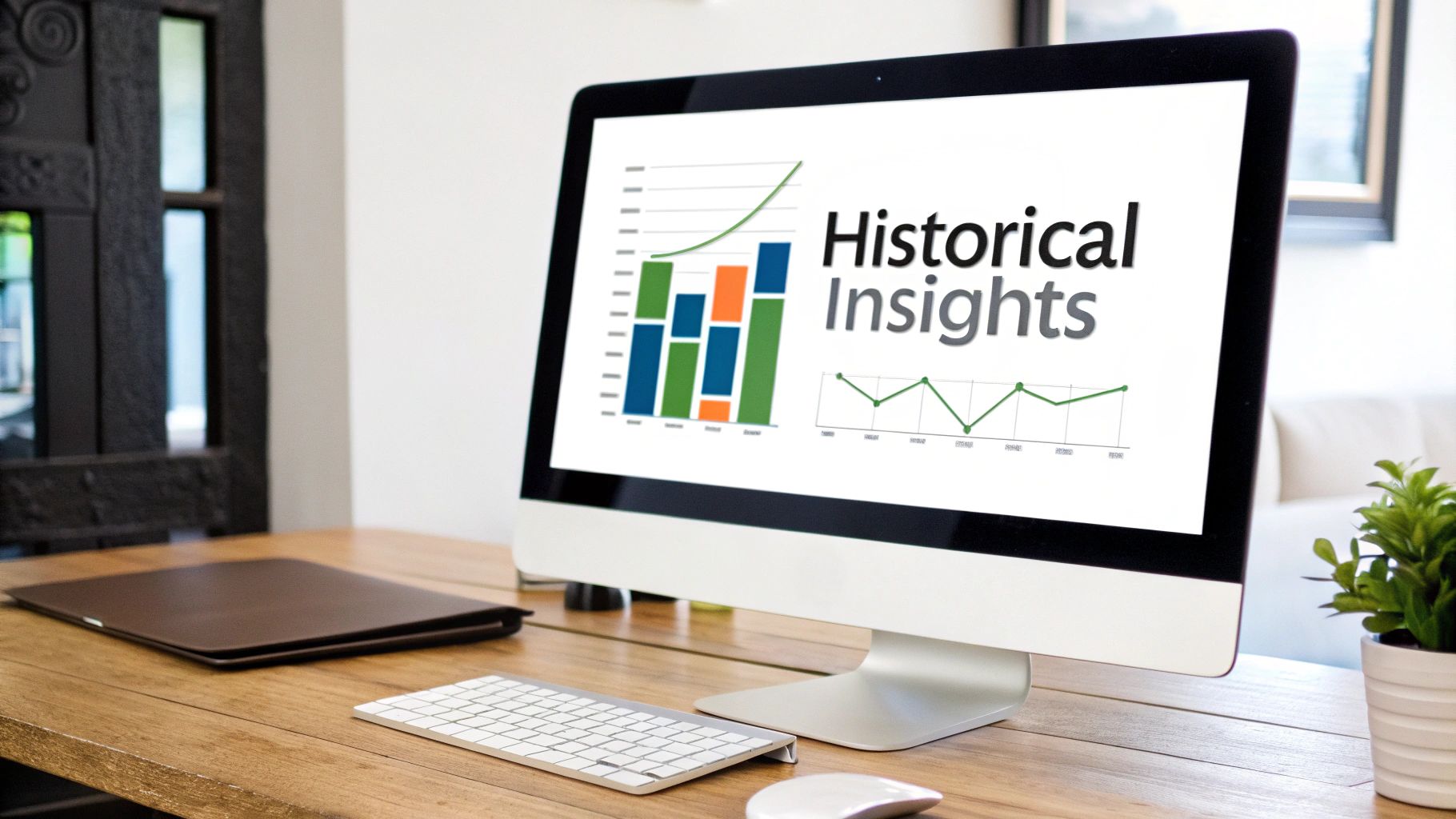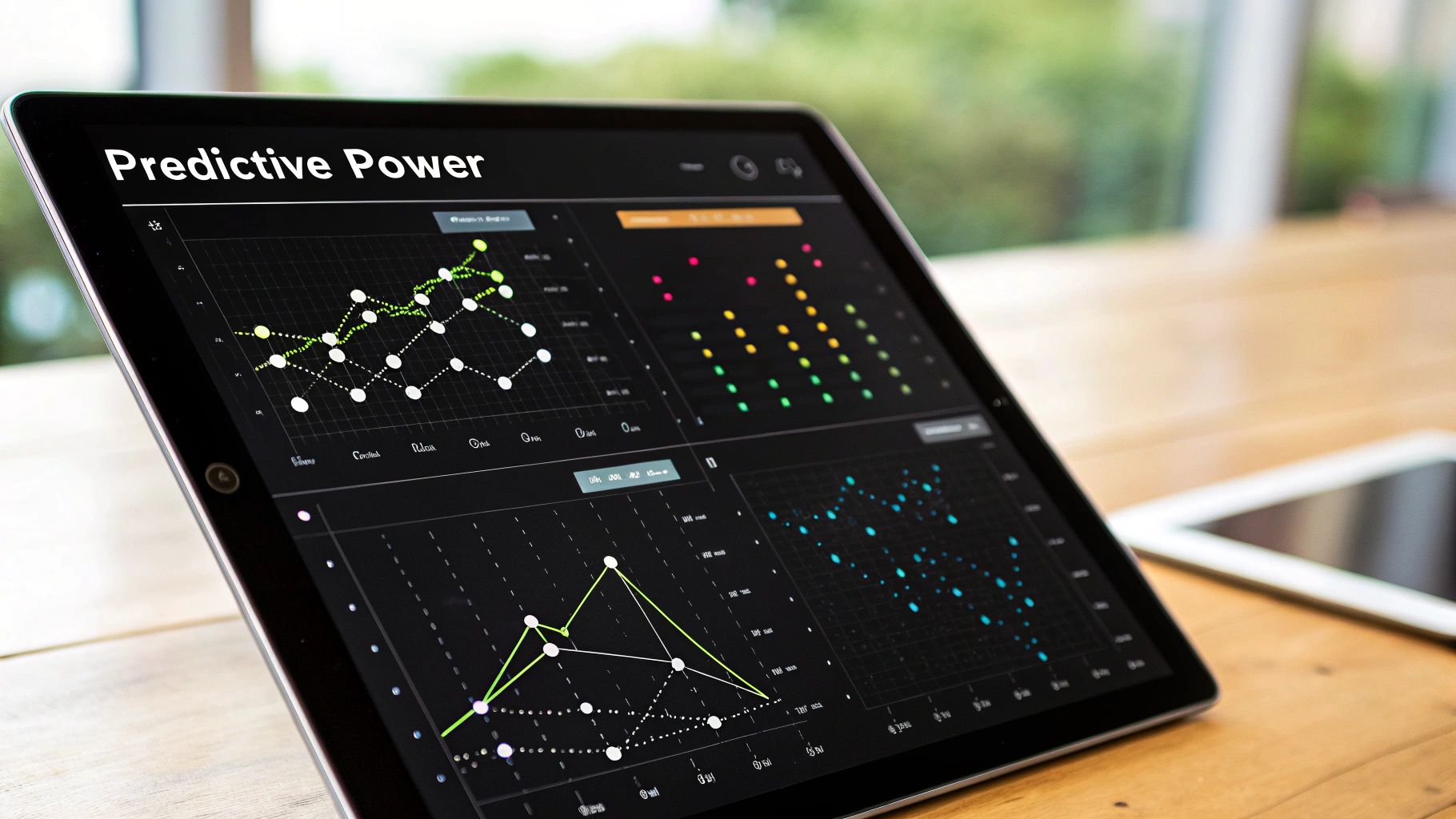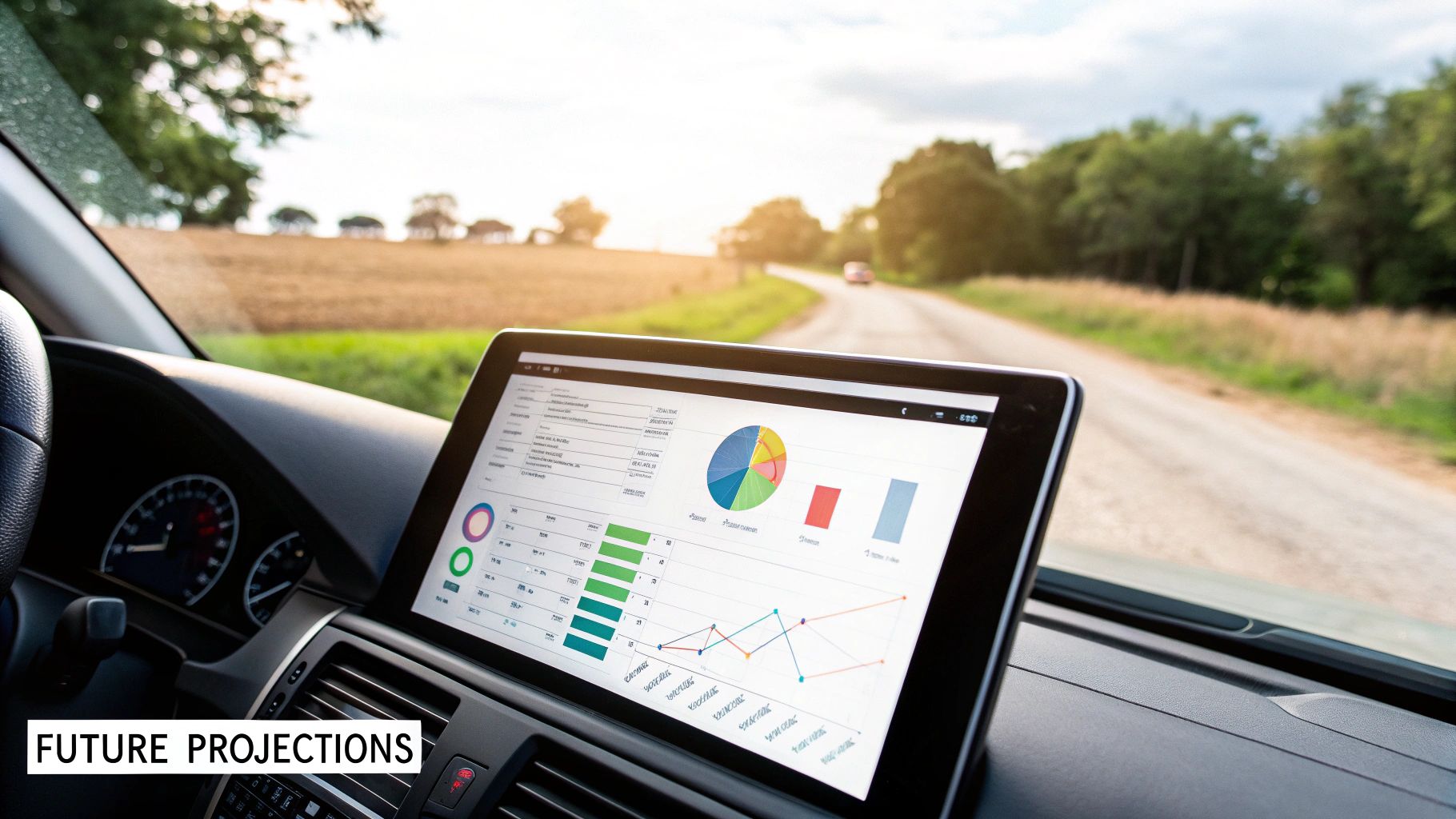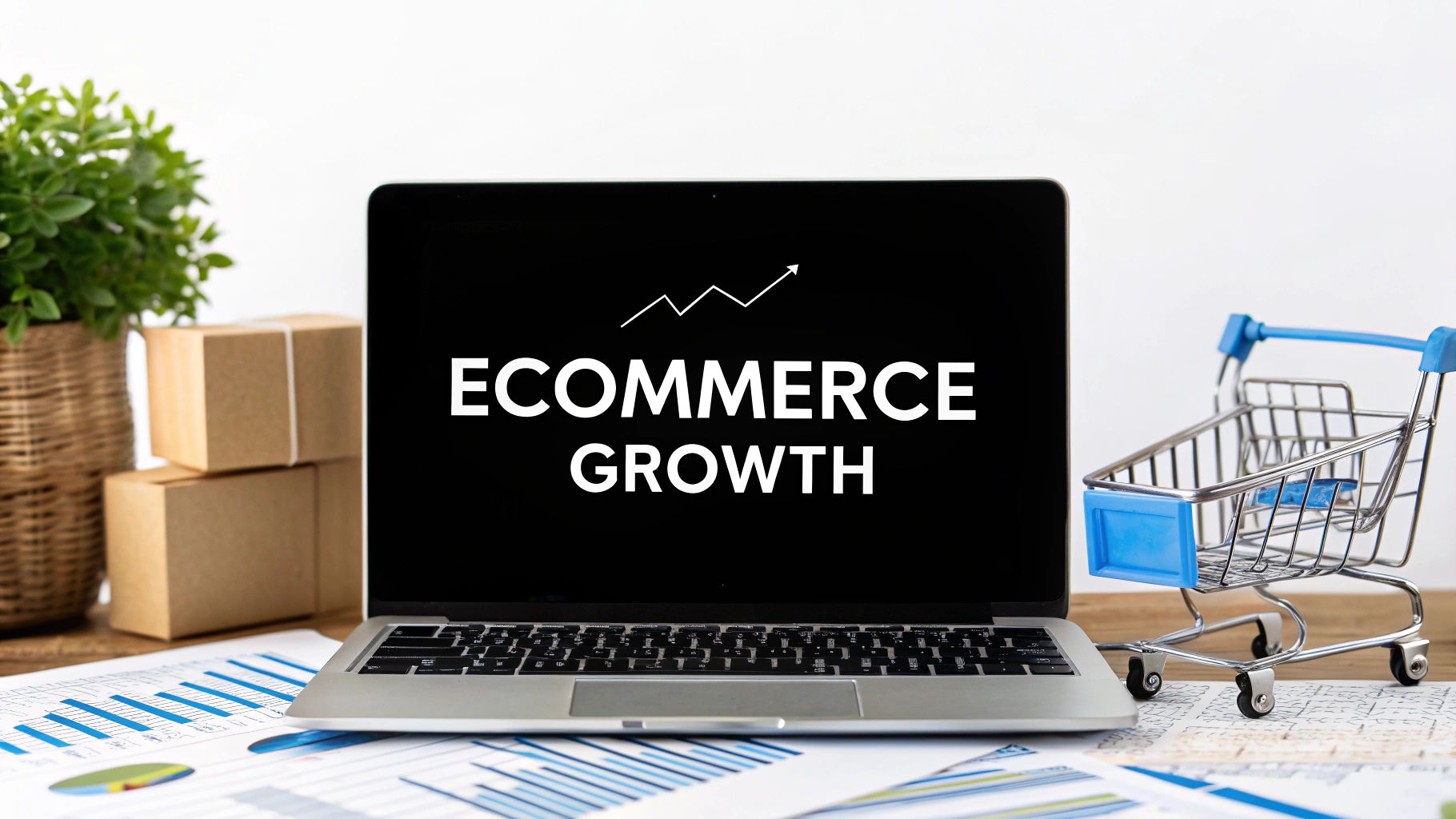The Science Behind Effective Ecommerce Sales Forecast

Traditional forecasting methods often miss the mark in the dynamic world of ecommerce. The speed of online shopping, influenced by countless factors, makes it difficult for traditional models to keep up. Social media trends, online reviews, and competitor pricing can all quickly change consumer demand. This requires a more adaptable and insightful approach to ecommerce sales forecasting.
Understanding the Ecommerce Landscape
Creating an effective ecommerce sales forecast starts with understanding the specific factors that influence online purchasing. This goes beyond simple historical sales data. Think about metrics like website traffic, conversion rates, average order value, and customer lifetime value. External factors, like economic conditions, seasonality, and new trends, also play a significant role. Grasping these interconnected elements is key to building a solid forecast.
Leveraging Customer Journey Data
Top ecommerce brands are using customer journey data to predict future buying behavior. This involves analyzing every interaction a customer has with the brand. From initial website visits and product views to adding items to their cart and completing a purchase, every touchpoint offers valuable information. This detailed data provides crucial insights into customer preferences, buying habits, and potential roadblocks. Businesses can then identify patterns and predict future sales with increased accuracy.
Key Components of Effective Forecasting
A comprehensive strategy is essential for building an effective ecommerce sales forecast. Several key components should be included:
- Digital Touchpoint Analysis: Understanding how customers interact with your online platforms is essential.
- Seasonal Pattern Recognition: Identifying recurring trends and adjusting forecasts is crucial for accuracy.
- Competitor Analysis: Monitoring competitor activities and their potential impact helps you stay ahead of the curve.
- Market Trend Awareness: Staying informed about broader market changes and evolving consumer behavior is essential for long-term success.
For example, the UK e-commerce market is expected to see significant growth. Online retail sales are projected to reach £128.8 billion by 2025, a 4.5% increase from the previous year. This growth, driven largely by non-food online sales, highlights the importance of robust online strategies. Find more detailed statistics here. This reinforces the need to integrate market-specific data into your forecasting models.
Successful ecommerce operations treat forecasting as a continuous process of improvement. By using a data-driven approach and adapting to the constantly evolving online marketplace, businesses can transform forecasting from a routine task into a powerful tool for strategic growth. This approach allows for greater flexibility and a more effective response to market changes.
Data-Driven Methods That Actually Deliver Results

Moving beyond basic analytics unlocks the potential of advanced forecasting methods. These methods can significantly improve the accuracy of your ecommerce sales forecasts, transforming raw data into valuable business insights. Successful ecommerce brands leverage a combination of historical transaction data and an understanding of browsing behavior. This allows them to anticipate future sales with remarkable precision.
Identifying Meaningful Patterns
Effective forecasting hinges on the ability to distinguish meaningful patterns from random fluctuations. Not every change in sales data indicates a significant trend. For instance, a sudden surge in sales from a flash sale doesn't necessarily signify a long-term increase in demand.
By focusing on the metrics that truly matter, businesses can develop more reliable projections. Key metrics often include average order value, customer lifetime value, and conversion rates.
Understanding which data points are truly valuable is crucial for accurate sales forecasting. It's similar to panning for gold – sifting through irrelevant information to uncover the valuable nuggets of insight that will inform your predictions.
Implementing Forecasting Models
A variety of forecasting models are available, ranging from traditional time series analysis to more sophisticated machine learning algorithms. Even without advanced statistical expertise, businesses can effectively implement these models to improve their ecommerce sales forecasts. Tools like Mergoio offer user-friendly interfaces and the necessary functionalities to make this possible.
-
Time series analysis: This method uses historical sales data to identify trends and patterns, making it useful for predicting future sales based on past performance.
-
Machine learning algorithms: These powerful models analyze large datasets to uncover complex relationships and predict future outcomes with greater accuracy.
Building Adaptable Prediction Systems
Creating a prediction system tailored to your specific business needs is paramount. The following table compares various ecommerce forecasting methods to help guide your decision-making process:
To help illustrate the different approaches, let's take a look at a comparison of several common methods. The following table highlights the strengths and weaknesses of each:
| Forecasting Method | Accuracy Level | Data Requirements | Implementation Complexity | Best Use Case |
|---|---|---|---|---|
| Time Series Analysis | Moderate | Historical Sales Data | Low | Short-term forecasting, established products |
| Regression Analysis | Moderate to High | Sales data & related factors (e.g., marketing spend) | Moderate | Understanding the impact of various factors on sales |
| Machine Learning | High | Large datasets of historical sales, customer behavior, and market data | High | Long-term forecasting, new product launches, complex market dynamics |
This table showcases how different methods cater to various needs and levels of complexity. Choosing the right model depends on the specific requirements of your business and the data available.
Different product categories and customer segments will exhibit unique sales patterns. Your ecommerce sales forecast should account for these nuances. For example, a clothing retailer might experience sales peaks during seasonal changes, while an electronics retailer may see increased demand during holiday shopping seasons. These patterns should be factored into their respective forecasts.
Through practical guidance and real-world examples, businesses can learn how to build and refine their prediction systems. Using the right tools and techniques makes even complex forecasting methodologies accessible. This data-driven approach empowers businesses to optimize inventory management, refine marketing strategies, and ultimately, boost profitability. This adaptability ensures forecasts remain accurate even in a constantly evolving online market.
Reading Market Signals Beyond Your Dashboard

Accurate ecommerce sales forecasts depend on more than just the data you collect internally. Success requires a comprehensive understanding of the broader market and incorporating relevant external signals. These signals, which can include anything from consumer sentiment on social media to competitor pricing strategies, can significantly impact your sales.
Identifying Key External Signals
Figuring out which external factors are most relevant to your specific product categories is a critical first step. For example, if your business focuses on fashion apparel, social media trends and influencer marketing campaigns are likely to be strong indicators of future demand. If you sell industrial equipment, however, economic indicators and industry reports may be more valuable. This targeted approach allows you to efficiently track the most impactful signals.
Incorporating External Data Into Your Model
Once you've identified the key signals, you need to quantify them and integrate them into your ecommerce sales forecast. This could involve tracking social media mentions of your brand, monitoring changes in competitor pricing, or analyzing economic data relevant to your industry. Tools like Mergoio can simplify this process by providing a centralized platform for data aggregation and analysis, leading to more efficient and accurate forecasting.
Weighing and Validating Market Indicators
It's crucial to remember that not all external signals carry the same weight. Develop a framework for evaluating the relative importance of different indicators. A sudden surge in negative social media sentiment, for instance, is likely more concerning than a gradual increase in competitor advertising spend. This prioritization helps ensure your forecasts are driven by the most significant factors. Validating the impact of these indicators on your past sales performance is equally important. This involves analyzing how well changes in each indicator correlate with actual sales fluctuations.
The UK e-commerce market provides a good example of a dynamic landscape shaped by a growing user base and evolving consumer preferences. By 2025, there will be an estimated 62.1 million e-commerce users in the UK, demonstrating significant market potential. Explore this topic further. Consumer expectations around delivery speed are also changing, with over 50% of UK residents valuing same-day delivery and over 60% expecting next-day delivery. This emphasizes the need for businesses to account for these external market forces in their ecommerce sales forecasting. By effectively integrating external data, you can transition from reactive strategies to a proactive approach, positioning your business for success in the constantly changing world of ecommerce.
Mastering Seasonal Patterns in Your Forecast Model

Seasonality plays a crucial role in accurate ecommerce sales forecasts. However, its impact is often underestimated and improperly addressed. Anticipating these fluctuations accurately can significantly impact profitability. This section explores how online retailers can effectively identify and leverage seasonal trends for optimized forecasts.
Identifying Seasonal Trends and Anomalies
Successful online retailers delve deep into their data to identify both prominent and subtle seasonal patterns influencing sales. Swimwear sales, for example, typically peak during the summer, while demand for winter apparel rises during colder months.
However, less obvious trends, such as back-to-school shopping or cultural events, also impact sales. Distinguishing these true seasonal trends from isolated events, like flash sales, is essential for a reliable forecast. Mistaking anomalies for recurring trends can skew predictions and lead to ineffective inventory management.
Handling Overlapping Seasonal Effects
Ecommerce sales forecasting becomes complex when multiple seasonal influences overlap. For instance, Q4 experiences the combined effects of Black Friday, Cyber Monday, and the general holiday shopping season.
Furthermore, even weekly patterns, such as increased weekend activity, can impact daily sales. Tools like Mergoio enable businesses to incorporate these various layers into their forecast models. This granular analysis allows for more precise sales predictions, improved inventory planning, and optimized resource allocation.
Adjusting for Market Volatility
Even the most meticulous ecommerce sales forecasts can be disrupted by external events. Unexpected economic downturns, supply chain disruptions, and shifts in consumer behavior introduce significant volatility. Maintaining forecast accuracy during such turbulence requires robust adjustment strategies.
Analyzing historical data from similar past events can offer insights into potential impact. Incorporating external market indicators, like consumer confidence indices or industry reports, into your model can also prove beneficial. By combining these techniques, businesses can create more adaptable forecasts that remain reliable despite market fluctuations.
To help illustrate the varying impact of seasonality across different ecommerce sectors, let's examine the following table:
Ecommerce Seasonal Impact by Industry
Statistical data showing how different ecommerce categories experience seasonal fluctuations throughout the year
| Industry Category | Q1 Impact | Q2 Impact | Q3 Impact | Q4 Impact | Key Seasonal Events |
|---|---|---|---|---|---|
| Apparel | Moderate | High (Summer Apparel) | Moderate | High (Holiday Shopping) | Back-to-School, Black Friday, Cyber Monday, Holiday Season |
| Electronics | Moderate | Moderate | Moderate | High (Holiday Shopping, New Product Releases) | Black Friday, Cyber Monday, Holiday Season |
| Home & Garden | High (Spring Cleaning, Home Improvement) | High (Outdoor Living) | Moderate | Moderate | Spring Cleaning, Summer Holidays |
| Toys & Games | Low | Low | Moderate | High (Holiday Shopping) | Holiday Season |
| Sporting Goods | Moderate | High (Summer Sports) | Moderate | Moderate | Summer Holidays, Start of School Year |
This table highlights the significant impact of seasonality on various ecommerce industries. While Q4 generally sees increased activity due to holiday shopping, other sectors, like Home & Garden, experience peaks during different times of the year. Understanding these industry-specific patterns is essential for accurate forecasting.
By recognizing the nuances of seasonal trends, effectively managing overlapping influences, and adjusting for market volatility, businesses can significantly improve the accuracy and reliability of their ecommerce sales forecasts. This leads to better inventory management, optimized resource allocation, and ultimately, increased profitability.
Technology Tools That Transform Your Forecast Accuracy
Having accurate ecommerce sales forecasts can be a game-changer for your business. The right technology can significantly improve your predictions, saving you countless hours previously spent on manual data analysis. However, it's not just about finding software with impressive features; it's about finding the right fit for your specific needs and successfully integrating those tools into your existing workflows. This will streamline your operations and unlock valuable insights.
Evaluating Forecasting Platforms
There's a wide variety of forecasting platforms on the market, each with its own advantages and disadvantages. Some are geared towards smaller businesses, while others are designed for larger enterprises. When evaluating these platforms, consider key features such as data integration capabilities, available forecasting model options, and reporting functionalities.
Some platforms specialize in time series analysis, which looks at historical data to predict future trends, while others might focus on machine learning algorithms, which can identify more complex patterns. Understanding these differences is essential for choosing a platform aligned with your specific ecommerce sales forecasting requirements. Platforms like Mergoio offer user-friendly interfaces for a range of methods, making even sophisticated techniques accessible to those without a data science background.
Seamless Prediction Workflows
Successful online retailers seamlessly integrate specialized forecasting tools with their existing systems. This typically involves connecting the forecasting platform to your CRM (Customer Relationship Management), inventory management system, and other relevant data sources. This integration allows the platform to automatically pull in the necessary data, reducing manual data entry and minimizing the risk of errors.
The efficient exchange of data between your systems enables more frequent updates to your forecasts. This ensures you are always working with the most current information, a particularly valuable advantage during periods of high market volatility or rapid business growth.
The Role of AI and Machine Learning
AI (Artificial Intelligence) and machine learning are reshaping the ecommerce sales forecasting landscape. These technologies can identify complex patterns and relationships in your data that traditional methods might miss. This in-depth analysis can lead to more accurate predictions, which is especially crucial in dynamic markets.
However, it's important to maintain realistic expectations. While powerful, AI and machine learning aren’t magic solutions. They require high-quality data to produce reliable forecasts. Tools like Mergoio are designed for accessibility, allowing you to utilize the power of AI without needing to be a data scientist. This frees you to focus on interpreting the forecasts and applying those insights to your business strategies, rather than getting bogged down in complex technical details.
Addressing Implementation Challenges
Implementing new forecasting technology can present certain challenges, including data migration issues, system integration complexities, and the need for employee training. Careful planning and close collaboration with your technology provider can help mitigate these potential issues.
Another important factor is the scalability of the platform. You should select a solution that can grow alongside your business, handling increasing data volumes and evolving business needs. Starting with a solution like Mergoio can not only address your current needs but also position your business to proactively adapt to the ever-changing ecommerce environment.
Turning Forecasts Into Profitable Inventory Decisions
The true power of an ecommerce sales forecast lies in its ability to inform smart inventory decisions. This means transforming predictions into actionable strategies. These strategies optimize product availability while minimizing costs. This careful balancing act is essential for maximizing profitability and ensuring customer satisfaction.
Balancing Availability and Capital Efficiency
Leading ecommerce brands understand that inventory management is a delicate balance. Too much inventory ties up valuable capital and risks obsolescence. Too little inventory leads to stockouts and lost sales. This is where the ecommerce sales forecast becomes invaluable. It provides the insights needed to find the sweet spot. This sweet spot is having enough inventory to meet demand without unnecessary overstocking.
Imagine a small online retailer selling handmade jewelry. Using an ecommerce sales forecast, they can predict a spike in demand during the holiday season. This allows them to increase inventory strategically. They can then ensure they have enough stock to meet the anticipated surge in orders. This proactive approach avoids lost sales opportunities. It also maximizes revenue during peak periods.
Differentiated Stocking Strategies
Successful businesses don’t treat all products equally regarding inventory. They develop differentiated stocking approaches based on several factors:
- Forecast Confidence Levels: Products with highly predictable demand may require less safety stock. Products with volatile sales patterns necessitate a larger buffer.
- Product Characteristics: Perishable goods, seasonal items, and products with long lead times demand specific inventory strategies. These strategies are tailored to their unique properties.
This nuanced approach ensures efficient inventory allocation across the entire product portfolio. It aligns stock levels with demand variability and specific product needs. Tools like Mergoio offer advanced forecasting capabilities. These capabilities are necessary to implement these differentiated strategies. They allow you to fine-tune your approach for each product.
Calculating Safety Stock
Safety stock acts as a buffer against forecast inaccuracies and unexpected demand fluctuations. It's like having an insurance policy for your inventory. Calculating the appropriate level of safety stock is crucial. Too much leads to excessive carrying costs. Too little exposes you to stockouts.
Effective techniques for calculating safety stock involve analyzing historical sales data. They also include considering lead times and factoring in desired service levels. This approach ensures you have sufficient stock to meet customer demand, even when forecasts aren't perfect. This minimizes disruptions and maximizes customer satisfaction.
Handling Challenging Inventory Scenarios
Ecommerce businesses frequently encounter challenging inventory situations. Products with long lead times, items with unpredictable return rates, and sudden shifts in demand can all create headaches. By using forecast data strategically, these challenges become manageable.
For example, imagine your ecommerce sales forecast predicts a strong upward trend for a product with a long lead time. You can proactively place larger orders in advance. This anticipatory approach minimizes the risk of stockouts during periods of peak demand. It ensures continuous product availability for your customers.
By using your ecommerce sales forecast to inform these decisions, you can prevent overstocking slow-moving items. You can also avoid missed sales opportunities and effectively manage unexpected events. This translates directly into improved profitability and enhanced customer satisfaction.
Ready to transform your inventory management and boost your bottom line? Explore the power of Mergoio today!

Leave a Reply